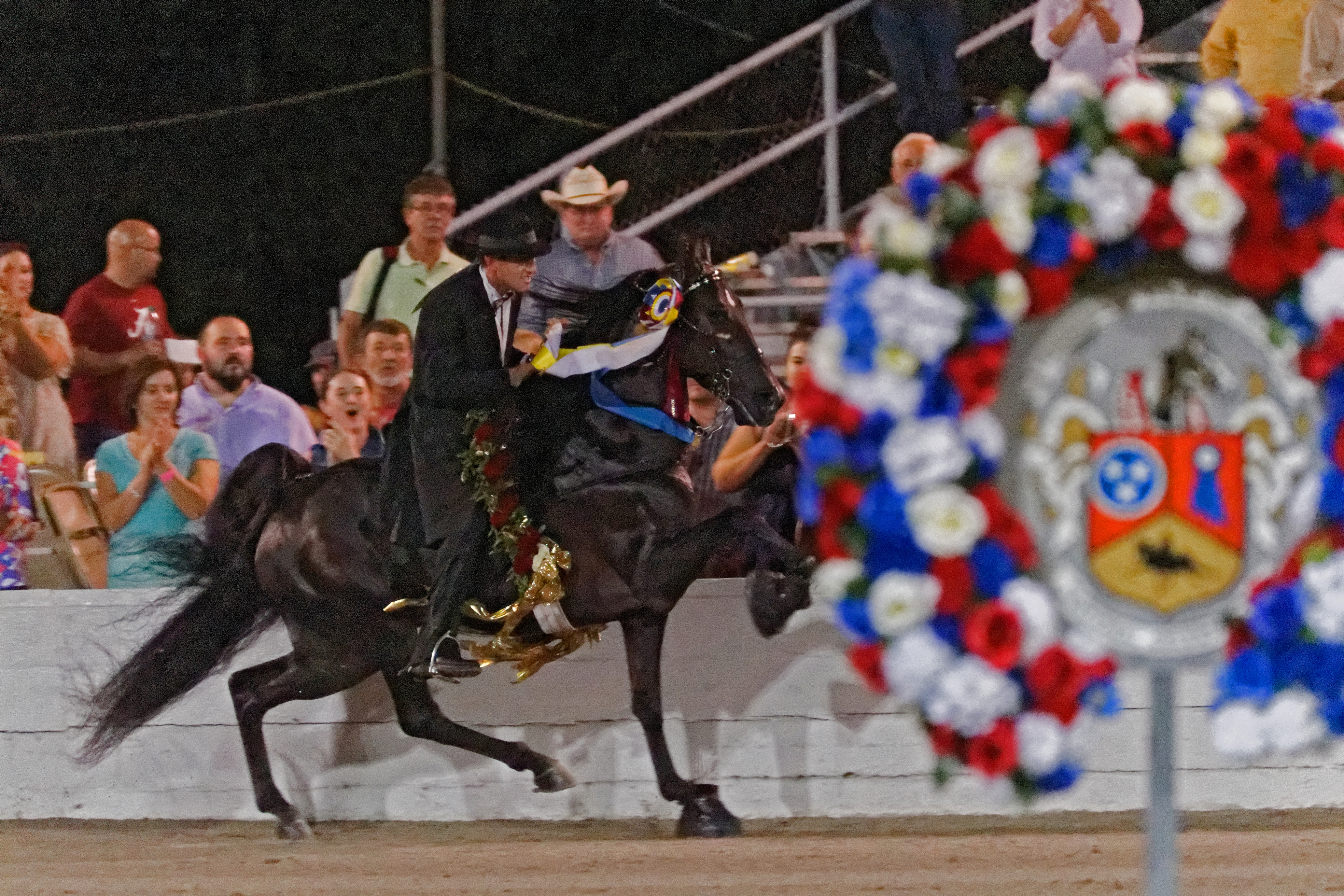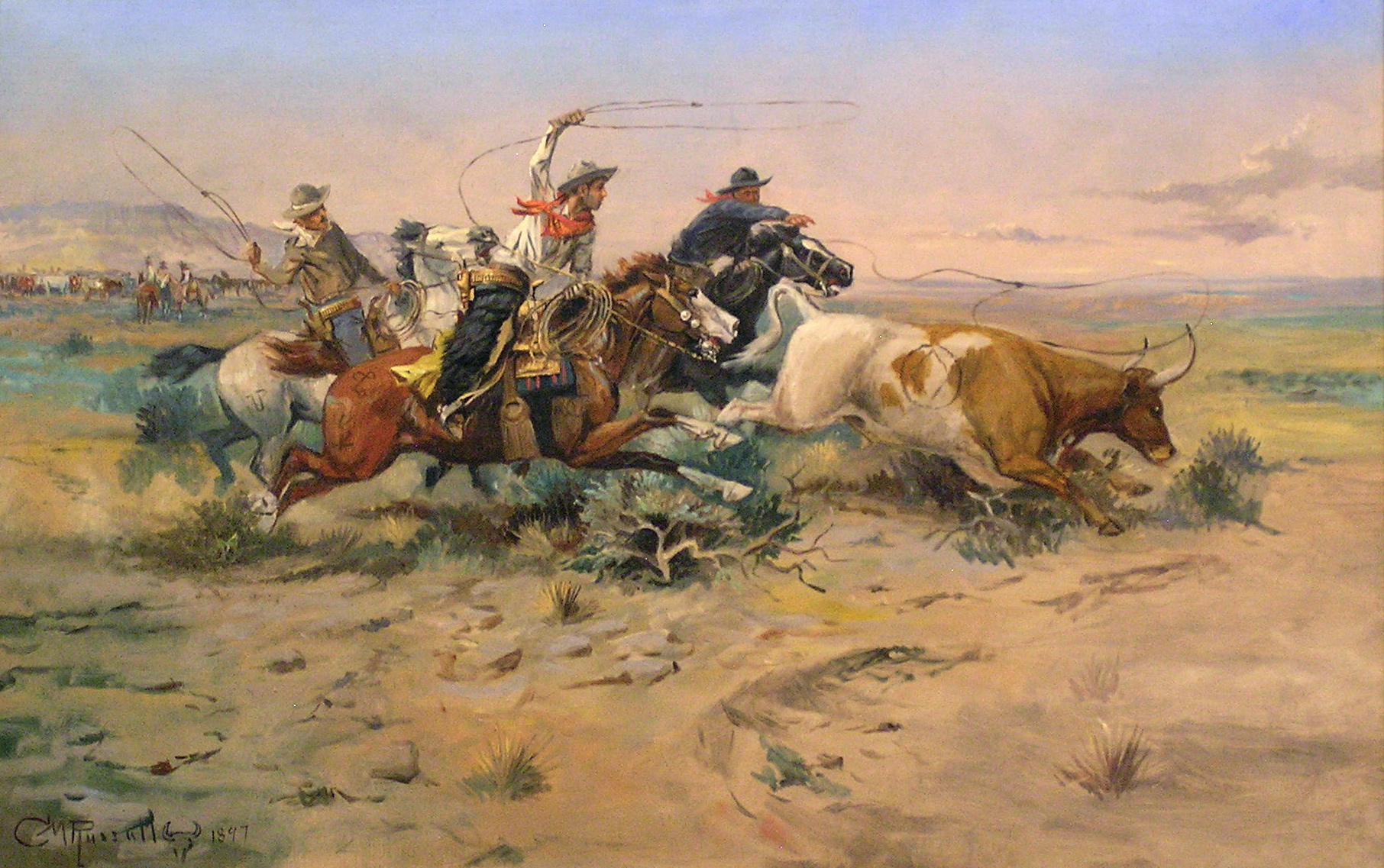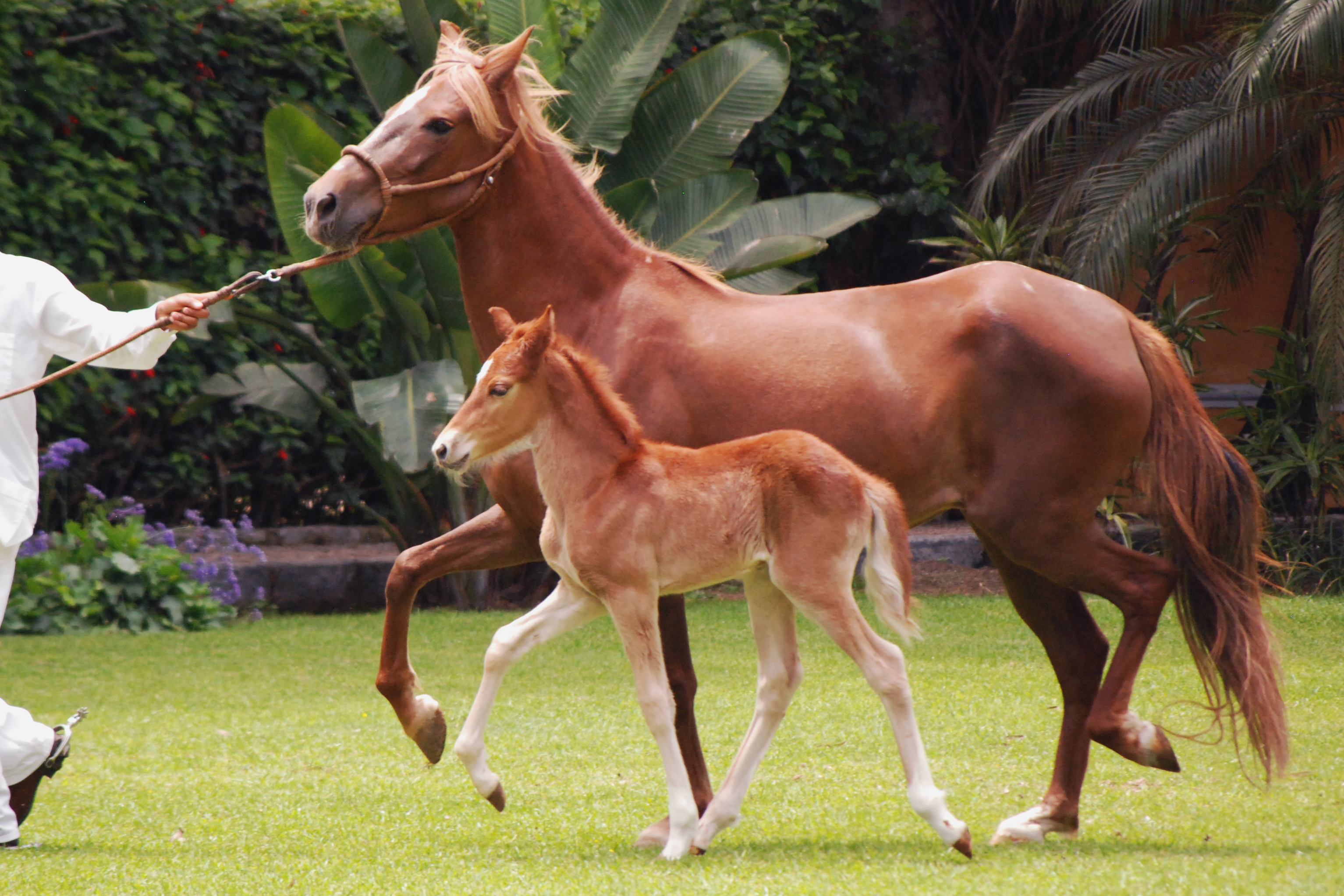|
Spotted Saddle Horse
The Spotted Saddle Horse is a horse breed from the United States that was developed by crossing Spanish-American type gaited pinto ponies with gaited horse breeds, such as the Tennessee Walking Horse. The result was a colorful, smooth-gaited horse, used in the show ring and for pleasure and trail riding. Two registries have been created for the breed, one in 1979 and the other in 1985. The two have similar registration requirements, although one has an open stud book and the other is slightly more strict with regard to parentage requirements, having a semi-closed stud book. The Spotted Saddle Horse is a light riding horse, always pinto in color. Solid-colored foals from registered parents may be registered for identification purposes, so their pinto-colored foals have documented parentage. They always perform an ambling gait, rather than a trot, in addition to the gaits of walk and canter, performed by all breeds. History The Spotted Saddle Horse developed from small ... [...More Info...] [...Related Items...] OR: [Wikipedia] [Google] [Baidu] |
Pinto Horse
A pinto horse has a coat color that consists of large patches of white and any other color. Pinto coloration is also called paint, particolored, or in nations that use British English, simply coloured. Pinto horses have been around since shortly after the domestication of the horse. Pinto colors can come in a number of genetically distinct patterns, which have different visual characteristics and tend to make white or leave colored different areas of the horse. These include tobiano, sabino, splashed white, frame, and manchado. A pinto horse may also have a combination of these patterns, such as tovero. Pinto patterns can be found in various breeds of horses, notably including the American Paint Horse. Color breed registries such as the Pinto Horse Association of America record pedigree and horse show results for pinto horses, regardless of ancestry. Both the terms "Pinto" and "Paint" may sometimes refer to breeds or registries rather than coat color. Pinto patterns are vi ... [...More Info...] [...Related Items...] OR: [Wikipedia] [Google] [Baidu] |
Soring
Soring is the use of chemicals, pressure or devices to cause pain to the front feet and legs of horses when they touch the ground. This results in the horses picking up their front feet higher and faster than they would do naturally. Sometimes called "fixing", it is an abusive and prohibited practice, illegal in the U.S. under the Horse Protection Act of 1970 (HPA). It is closely associated with a unique high-stepping action of the front legs called "big lick" movement in show ring Tennessee Walking Horses. Under normal circumstances, "big lick" action is normally created by horseshoes that have added pads and weight (sometimes called "stacks"), usually combined with additional weighted chains or rollers placed around the pasterns to create dramatic, high-stepping action of the horse's front legs, desired in the horse show ring. Practitioners of soring do so because they believe that the pain associated with this practice exaggerates the "big lick" to a greater degree and gi ... [...More Info...] [...Related Items...] OR: [Wikipedia] [Google] [Baidu] |
Murfreesboro, Tennessee
Murfreesboro is a city in Rutherford County, Tennessee, United States, and its county seat. Its population was 165,430 according to the 2023 census estimate, up from 108,755 residents certified in 2010 United States census, 2010. Murfreesboro is located in the Nashville metropolitan area of Middle Tennessee, southeast of downtown Nashville, Tennessee, Nashville. It served as the state capital from 1818 to 1826. Today, it is the largest suburb of Nashville and the List of municipalities in Tennessee, sixth-most populous city in Tennessee. The city is both the center of population and the geographic center of Tennessee. Since the 1990s, Murfreesboro has been Tennessee's fastest-growing major city and one of the fastest-growing cities in the country. Murfreesboro is home to Middle Tennessee State University, one of the largest undergraduate universities in the state of Tennessee, with 20,540 total students as of fall 2024. History On October 27, 1811, the Tennessee General Ass ... [...More Info...] [...Related Items...] OR: [Wikipedia] [Google] [Baidu] |
Selective Breeding
Selective breeding (also called artificial selection) is the process by which humans use animal breeding and plant breeding to selectively develop particular phenotypic traits (characteristics) by choosing which typically animal or plant males and females will sexually reproduce and have offspring together. Domesticated animals are known as breeds, normally bred by a professional breeder, while domesticated plants are known as varieties, cultigens, cultivars, or breeds. Two purebred animals of different breeds produce a crossbreed, and crossbred plants are called hybrids. Flowers, vegetables and fruit-trees may be bred by amateurs and commercial or non-commercial professionals: major crops are usually the provenance of the professionals. In animal breeding artificial selection is often combined with techniques such as inbreeding, linebreeding, and outcrossing. In plant breeding, similar methods are used. Charles Darwin discussed how selective breeding had been succ ... [...More Info...] [...Related Items...] OR: [Wikipedia] [Google] [Baidu] |
American West
The Western United States (also called the American West, the Western States, the Far West, the Western territories, and the West) is census regions United States Census Bureau As American settlement in the U.S. expanded westward, the meaning of the term ''the West'' changed. Before around 1800, the crest of the Appalachian Mountains was seen as the western frontier. The frontier moved westward and eventually the lands west of the Mississippi River were considered ''the West''. The U.S. Census Bureau's definition of the 13 westernmost states includes the Rocky Mountains and the Great Basin to the Pacific Coast, and the mid-Pacific islands state, Hawaii. To the east of the Western United States is the Midwestern United States and the Southern United States, with Canada to the north and Mexico to the south. The West contains several major biomes, including arid and semi-arid plateaus and plains, particularly in the American Southwest; forested mountains, including thr ... [...More Info...] [...Related Items...] OR: [Wikipedia] [Google] [Baidu] |
Mustang Horse
The mustang is a free-roaming horse of the Western United States, descended from horses brought to the Americas by the Spanish conquistadors. Mustangs are often referred to as wild horses, but because they are descended from once-Domestication of the horse, domesticated animals, they are actually feral horses. The original mustangs were Colonial Spanish horses, but many other breeds and types of horses contributed to the modern mustang, now resulting in varying phenotypes. Some free-roaming horses are relatively unchanged from the original Spanish stock, most strongly represented in the most isolated populations. In 1971, the United States Congress recognized that "wild free-roaming horses and burros are living symbols of the historic and pioneer spirit of the West, which continue to contribute to the diversity of life forms within the Nation and enrich the lives of the American people." The free-roaming horse population is managed and protected by the Bureau of Land Manageme ... [...More Info...] [...Related Items...] OR: [Wikipedia] [Google] [Baidu] |
Peruvian Paso
The Peruvian Horse is a breed of light saddle horse known for its smooth ride. It is distinguished by a natural, four-beat, lateral gait called the ''paso llano.'' This breed is protected by the Peruvian government through Decree number 25919 of Peru enacted on November 28, 1992, and has been declared a Cultural Heritage of the Nation by the National Institute of Culture (INC). Due to the isolation suffered for about 400 years and the selection made by their breeders, this breed is very particular in their body proportions and an ambling gait or "paso llano" that is characteristic. It is typical of the northern Peruvian regions of the country from which it originated. Trujillo city is considered the cradle of typical Peruvian Horses. History Smooth-gaited horses, generally known as Palfreys, existed in the Middle Ages, and the Jennet in particular was noted for its ambling gaits. Peruvians trace their ancestry to these ambling Jennets; as well as to the Barb, which contribut ... [...More Info...] [...Related Items...] OR: [Wikipedia] [Google] [Baidu] |
Paso Fino
The Paso Fino is a naturally gaited light horse breed dating back to horses imported to the Caribbean from Spain. ''Pasos'' are prized for their smooth, natural, four-beat, lateral ambling gait; they are used in many disciplines, but are especially popular for trail riding. In the United States two main groups of horses are popularly called "Paso Fino": One, also known as the Paso Fino Puro Puertorriqueño, originated in Puerto Rico. The other, often called the Colombian Paso Fino or Colombian Criollo Horse, developed in Colombia. Though from similar Spanish ancestors, the two groups developed independently of one another in their home nations. History The Paso Fino name means 'fine step'. The Paso Fino is a blend of the Barb, Spanish Jennet, and Andalusian horse and was bred by Spanish land owners in Puerto Rico and Colombia to be used in the plantations because of their endurance and comfortable ride. All Pasos share their heritage with the Peruvian Paso, the American Mu ... [...More Info...] [...Related Items...] OR: [Wikipedia] [Google] [Baidu] |
Missouri Fox Trotter
The Missouri Fox Trotter is a horse breed that originated in the state of Missouri in the United States. It was developed in the Ozark Mountains by settlers in the early 19th century, and quickly developed into a gaited breed appreciated for its stock horse abilities, stamina and smooth gaits. It performs an ambling gait known as the "fox trot", a four-beat broken diagonal gait in which the front foot of the diagonal pair lands before the hind, eliminating the moment of suspension and increasing smoothness. The main breed registry was begun in 1948 and as of 2012 registers almost 100,000 horses. A European registry was begun in 1992, and as of 2009 recognizes around 600 Fox Trotters living in Europe. In 2006, a smaller registry, focused on the preservation of the original, historic type, was begun in the United States. The Fox Trotter is a mid-sized, muscular breed, used mainly for trail riding and ranch work. Breed characteristics Missouri Fox Trotters stand high, and weigh ... [...More Info...] [...Related Items...] OR: [Wikipedia] [Google] [Baidu] |
American Civil War
The American Civil War (April 12, 1861May 26, 1865; also known by Names of the American Civil War, other names) was a civil war in the United States between the Union (American Civil War), Union ("the North") and the Confederate States of America, Confederacy ("the South"), which was formed in 1861 by U.S. state, states that had Secession in the United States, seceded from the Union. The Origins of the American Civil War, central conflict leading to war was a dispute over whether Slavery in the United States, slavery should be permitted to expand into the western territories, leading to more slave states, or be prohibited from doing so, which many believed would place slavery on a course of ultimate extinction. Timeline of events leading to the American Civil War, Decades of controversy over slavery came to a head when Abraham Lincoln, who opposed slavery's expansion, won the 1860 presidential election. Seven Southern slave states responded to Lincoln's victory by seceding f ... [...More Info...] [...Related Items...] OR: [Wikipedia] [Google] [Baidu] |
Horse Gait
Horses can use various gaits (patterns of leg movement) during Terrestrial locomotion, locomotion across solid ground, either naturally or as a result of specialized horse training, training by humans.Ensminger, M. E. ''Horses and Horsemanship'' 6th edition USA: Interstate Publishers 1990 pp. 65–66 Classification Gait, Gaits are typically categorized into two groups: the "natural" gaits that most horses will use without special training, and the "Ambling gait, ambling" gaits that are various smooth-riding, four-beat footfall patterns that may appear naturally in some individuals. Special training is often required before a horse will perform an ambling gait in response to a equestrianism, rider's command. Another system of classification that applies to Quadrupedalism, quadrupeds uses three categories: walking and ambling gaits, running or trotting gaits, and leaping gaits.Tristan David Martin Roberts (1995) ''Understanding Balance: The Mechanics of Posture and Locomotion'', ... [...More Info...] [...Related Items...] OR: [Wikipedia] [Google] [Baidu] |








